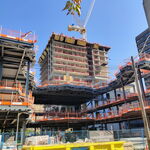The 20B is for the entire line from Quebec to Windsor. Of course this cannot be profitable.
However, for 11B we can go from Toronto to Montreal with a nice Ottawa stop in between.
This actually would be profitable and could be faster than planes in many cases. 1.5H for the Toronto to Ottawa. Only 1H from Montreal to Ottawa, and 2.5H from Toronto to Montreal, downtown to downtown, with no going out to the airport.
The study says that TO-Ott-Mon is profitable. 11B should be spent to do it.
It isn't just environmental savings. The highways would need less investment, we would need to build fewer of them and maintain them less.
Plus, do you believe gas prices are going down? Current airfare prices are unlikely to stay where they are in the future, so that rail would compete even better.
I would say it would likely be business travelers who would be the mainstay, but it would be great for tourists and downtowners as well as others looking to save some time and increase comfort on their trip.
Last point:
http://www.wnem.com/story/16041416/...rail-plan-moving-forward#.TsRtXpRzFUQ.blogger
Chicago is building a line to Detroit, which could in the future make a Windsor line feasible, since, you know, there is a metropolis of 5.5 million people on the other side of the river!!!





